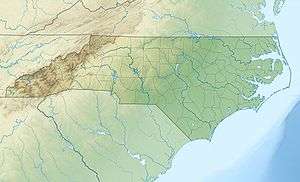McGuire Nuclear Station
| McGuire Nuclear Station | |
|---|---|
 McGuire Nuclear Station from Lake Norman | |
 Location of McGuire Nuclear Station in North Carolina | |
| Country | United States |
| Location | Mecklenburg County, near Huntersville, North Carolina |
| Coordinates | 35°25′57″N 80°56′54″W / 35.43250°N 80.94833°WCoordinates: 35°25′57″N 80°56′54″W / 35.43250°N 80.94833°W |
| Status | Operational |
| Commission date |
Unit 1: December 1, 1981 Unit 2: March 1, 1984 |
| Owner(s) | Duke Energy Corporation |
| Operator(s) | Duke Power Company |
| Nuclear power station | |
| Reactor type | pressurized water reactor |
| Reactor supplier | Westinghouse |
| Cooling source | Lake Norman |
| Cooling towers | no |
| Power generation | |
| Units operational | 2 x 1215 MW |
| Capacity factor | 91.4% |
| Average generation | 17,620 GWh |
|
Website www.duke-energy.com/.../mcguire | |
The McGuire Nuclear Station is a nuclear power plant located about 17 miles (27 km) northwest of Charlotte, North Carolina, on the state's largest lake, Lake Norman. It is a 32,500-acre (13,200 ha) lake created in 1963 by Duke Power for the Cowans Ford Hydroelectric Station. The McGuire units use the lake's water for cooling.
This plant has two Westinghouse pressurized water reactors and has a capability to produce 2,250 megawatts of net power, with a net generation of 17,514 GW·h in 2005. This represents 44% of the total nuclear power generation for the state of North Carolina.[1]
Ownership
McGuire Nuclear Station is operated by Duke Power Company and owned by the Duke Energy Corporation. It is named for William McGuire, who served as president of Duke Power from 1959 to 1971.[2]
License
The original operating licenses' dates of expiration were 2021-06-12 for Unit 1 and 2023-03-03 for Unit 2. In 2003, the Nuclear Regulatory Commission (NRC) renewed the licenses for both reactors for an additional twenty years.[3]
Surrounding population
The NRC defines two emergency planning zones around nuclear power plants: a plume exposure pathway zone with a radius of 10 miles (16 km), concerned primarily with exposure to, and inhalation of, airborne radioactive contamination, and an ingestion pathway zone of about 50 miles (80 km), concerned primarily with ingestion of food and liquid contaminated by radioactivity.[4]
The 2010 U.S. population within 10 miles (16 km) of McGuire was 199,869, an increase of 66.8 percent in a decade, according to an analysis of U.S. Census data for msnbc.com. The 2010 U.S. population within 50 miles (80 km) was 2,850,782, an increase of 23.3 percent since 2000. Cities within 50 miles include Charlotte (17 miles to city center).[5]
Seismic risk
The NRC's estimate of the risk each year of an earthquake intense enough to cause core damage to the reactor at McGuire was 1 in 32,258, according to an NRC study published in August 2010.[6][7]
Stator replacement project
During 2014 McGuire Nuclear Station powered down one of its units to undergo a routine refueling outage, critical to the operation of the plant. This outage was particularly significant because McGuire performed a major evolution – the replacement of a generator stator. The stator is part of the electric generator and is among the largest and heaviest components in the plant, weighing approximately 1.2 million pounds. The work was carried out by Siemens Energy Inc. The lifting contractor was Sarens who used a structural temporary lifting system to remove the existing Stator and install the new Stator. A specialist engineering company named Lowther-Rolton performed a "Technical Audit" of the lifting and installation engineering to ensure safety of operations. Lowther-Rolton were the original developers of the Technical Audit system for load movement operations.[8]
References
- ↑ "North Carolina Nuclear Industry". Energy Information Administration, U.S. Department of Energy (DOE). Retrieved 2008-11-17.
- ↑ Charlotte Observer article on the death of William McGuire Retrieved August 16, 2012
- ↑ "NRC Renews Licenses for Catawba and McGuire Nuclear Power Plants for an Additional 20 Years". Nuclear Regulatory Commission (NRC). December 5, 2003. Retrieved 2008-11-17.
- ↑ "Archived copy". Archived from the original on October 2, 2006. Retrieved March 14, 2012.
- ↑ Bill Dedman, Nuclear neighbors: Population rises near US reactors, msnbc.com, April 14, 2011 http://www.msnbc.msn.com/id/42555888/ns/us_news-life/ Accessed May 1, 2011.
- ↑ Bill Dedman, "What are the odds? US nuke plants ranked by quake risk," msnbc.com, March 17, 2011 http://www.msnbc.msn.com/id/42103936/ Accessed April 19, 2011.
- ↑ http://msnbcmedia.msn.com/i/msnbc/Sections/NEWS/quake%20nrc%20risk%20estimates.pdf
- ↑ http://lowther-rolton.com
External links
- Official Site From Duke Energy
- "McGuire Nuclear Power Plant, North Carolina". Energy Information Administration, U.S. Department of Energy (DOE). October 3, 2008. Retrieved 2008-11-17.
- "McGuire 1 Pressurized Water Reactor". Operating Nuclear Power Reactors. U.S. Nuclear Regulatory Commission (NRC). February 14, 2008. Retrieved 2008-11-17.
- "McGuire 2 Pressurized Water Reactor". Operating Nuclear Power Reactors. NRC. February 14, 2008. Retrieved 2008-11-17.